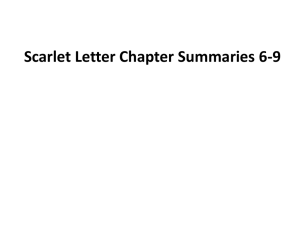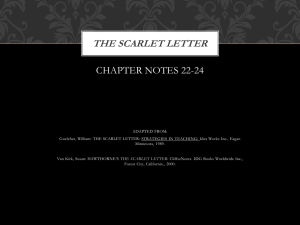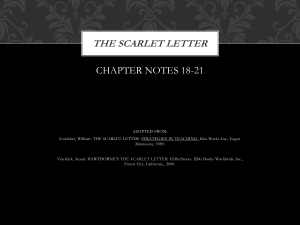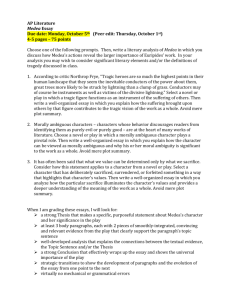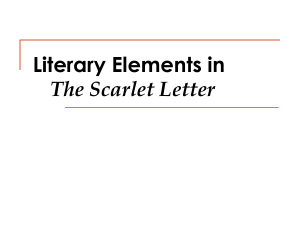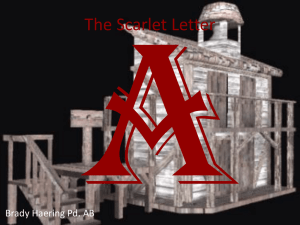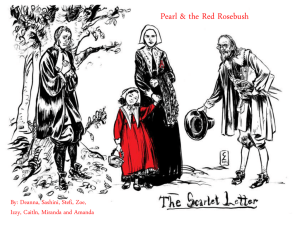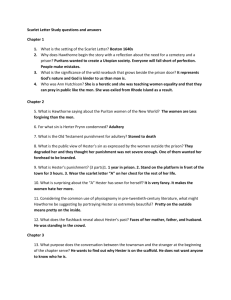Scarlet Letter Exam Prep
advertisement
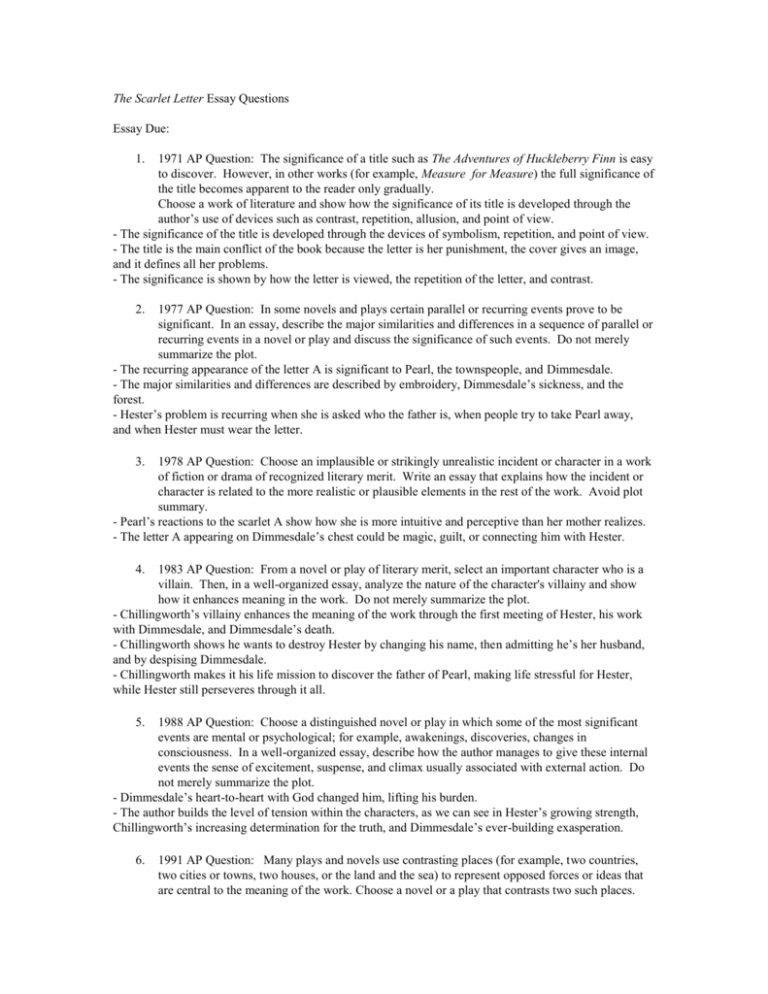
The Scarlet Letter Essay Questions Essay Due: 1. 1971 AP Question: The significance of a title such as The Adventures of Huckleberry Finn is easy to discover. However, in other works (for example, Measure for Measure) the full significance of the title becomes apparent to the reader only gradually. Choose a work of literature and show how the significance of its title is developed through the author’s use of devices such as contrast, repetition, allusion, and point of view. - The significance of the title is developed through the devices of symbolism, repetition, and point of view. - The title is the main conflict of the book because the letter is her punishment, the cover gives an image, and it defines all her problems. - The significance is shown by how the letter is viewed, the repetition of the letter, and contrast. 2. 1977 AP Question: In some novels and plays certain parallel or recurring events prove to be significant. In an essay, describe the major similarities and differences in a sequence of parallel or recurring events in a novel or play and discuss the significance of such events. Do not merely summarize the plot. - The recurring appearance of the letter A is significant to Pearl, the townspeople, and Dimmesdale. - The major similarities and differences are described by embroidery, Dimmesdale’s sickness, and the forest. - Hester’s problem is recurring when she is asked who the father is, when people try to take Pearl away, and when Hester must wear the letter. 3. 1978 AP Question: Choose an implausible or strikingly unrealistic incident or character in a work of fiction or drama of recognized literary merit. Write an essay that explains how the incident or character is related to the more realistic or plausible elements in the rest of the work. Avoid plot summary. - Pearl’s reactions to the scarlet A show how she is more intuitive and perceptive than her mother realizes. - The letter A appearing on Dimmesdale’s chest could be magic, guilt, or connecting him with Hester. 4. 1983 AP Question: From a novel or play of literary merit, select an important character who is a villain. Then, in a well-organized essay, analyze the nature of the character's villainy and show how it enhances meaning in the work. Do not merely summarize the plot. - Chillingworth’s villainy enhances the meaning of the work through the first meeting of Hester, his work with Dimmesdale, and Dimmesdale’s death. - Chillingworth shows he wants to destroy Hester by changing his name, then admitting he’s her husband, and by despising Dimmesdale. - Chillingworth makes it his life mission to discover the father of Pearl, making life stressful for Hester, while Hester still perseveres through it all. 5. 1988 AP Question: Choose a distinguished novel or play in which some of the most significant events are mental or psychological; for example, awakenings, discoveries, changes in consciousness. In a well-organized essay, describe how the author manages to give these internal events the sense of excitement, suspense, and climax usually associated with external action. Do not merely summarize the plot. - Dimmesdale’s heart-to-heart with God changed him, lifting his burden. - The author builds the level of tension within the characters, as we can see in Hester’s growing strength, Chillingworth’s increasing determination for the truth, and Dimmesdale’s ever-building exasperation. 6. 1991 AP Question: Many plays and novels use contrasting places (for example, two countries, two cities or towns, two houses, or the land and the sea) to represent opposed forces or ideas that are central to the meaning of the work. Choose a novel or a play that contrasts two such places. Write an essay explaining how the places differ, what each place represents, and how their contrast contributes to the meaning of the work. - The Scarlet Letter compares the town of Salem, where the characters reside, and the forest outside the city, where the devil supposedly lived. - In the forest, sin is not judged, it is dark, and it is open to all secrets as a meeting place for sinners. - Europe and America are often compared in a sense of vanity and purity. 1999 AP Question: The eighteenth-century British novelist Laurence Sterne wrote, “No body, but he who has felt it, can conceive what a plaguing thing it is to have a man’s mind torn asunder by two projects of equal strength, both obstinately pulling in a contrary direction at the same time.” From a novel or play choose a character (not necessarily the protagonist) whose mind is pulled in conflicting directions by two compelling desires, ambitions, obligations, or influences. Then, in a well-organized essay, identify each of the two conflicting forces and explain how this conflict within one character illuminates the meaning of the work as a whole. You may use one of the novels or plays listed below or another novel or play of similar literary quality. - Dimmesdale has conflicting internal forces. - Dimmesdale is torn between choosing a life with Hester and Pearl, or a life fulfilling his calling to the church. 7. 8. 2002 AP Question: Morally ambiguous characters—characters whose behavior discourages readers from identifying them as purely evil or purely good—are at the heart of many works of literature. Choose a novel or play in which a morally ambiguous character plays a pivotal role. Then write an essay in which you explain how the character can be viewed as morally ambiguous and why his or her moral ambiguity is significant to the work as a whole. Avoid mere plot summary. - Hester is a morally ambiguous character because she doesn’t care about her child and husband, but she did charity work and wants to be a family. - Dimmesdale is a morally ambiguous character due to his struggle between his knowledge of the right thing and his fear to actually do it. - Hester was an adulteress but she kept her husband’s identity a secret and became active in the church, and was very giving. 2002 (B): Often in literature a character’s success in achieving goals depends on keeping a secret and divulging it only at the right moment, if at all. Choose a novel or play of literary merit that requires a character to keep a secret. In a well-organized essay, briefly explain the necessity for secrecy and how the character’s choice to reveal or keep the secret affects the plot and contributes to the meaning of the work as a whole. - Hester has to keep Chillingworth’s identity a secret, and she has to keep Dimmesdale’s fatherhood a secret. - Chillingworth requires secrets regarding his identity and intentions to be kept in order to achieve his goal of vengeance upon Dimmesdale. - Hester must keep the secret of Pearl’s father in order to protect the father, her child, and herself from the judgmental beliefs of the townspeople. 9. 10. 2004: Critic Roland Barthes has said, “Literature is the question minus the answer.” Choose a novel or play and, considering Barthes’ observation, write an essay in which you analyze a central question the work raises and the extent to which it offers any answers. Explain how the author’s treatment of this question affects your understanding of the work as a whole. Avoid plot summary. - The Scarlet Letter raises the questions: are any sins unforgiveable, and what happens to people who cannot forgive themselves? 11. 2004 (B): The most important themes in literature are sometimes developed in scenes in which a death or deaths take place. Choose a novel or play and write a well-organized essay in which you show how a specific death scene helps to illuminate the meaning of the work as a whole. - Dimmesdale’s scene illuminates the theme by showing the culmination of his grief and the changes it causes in characters. 12. 2005: In Kate Chopin’s The Awakening (1899), protagonist Edna Pontellier is said to possess “that outward existence which conforms, the inward life which questions.” In a novel or play that you have studied, identify a character who conforms outwardly while questioning inwardly. Then write an essay in which you analyze how this tension between outward conformity and inward questioning contributes to the meaning of the work. Avoid mere plot summary. - Pearl questions the symbolism of the letter A, the existence of God, and Dimmesdale’s acceptance of the situation. 13. 2005 (B): One of the strongest human drives seems to be a desire for power. Write an essay in which you discuss how a character in a novel or a drama struggles to free himself or herself from the power of others or seeks to gain power over others. Be sure to demonstrate in your essay how the author uses this power struggle to enhance the meaning of the work. - Reverend Dimmesdale struggles to free himself from the lies and secrets, sin, and from the devil. - Chillingworth seeks to gain power over Hester, Dimmesdale, and the townspeople. 14. 2006: Many writers use a country setting to establish values within a work of literature. For example, the country may be a place of virtue and peace or one of primitivism and ignorance. Choose a novel or play in which such a setting plays a significant role. Then write an essay in which you analyze how the country setting functions in the work as a whole. Do not merely summarize the plot. - The setting plays a significant role because adultery was not taken lightly. The Puritans believed in the devil, looked down on sinners, and publicly shamed and outcast people who sinned. - Hawthorne uses the country setting to set up the closed mindedness of the townspeople toward Hester.
